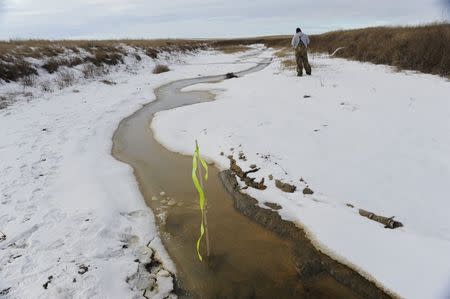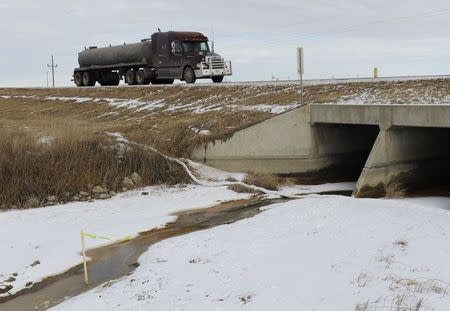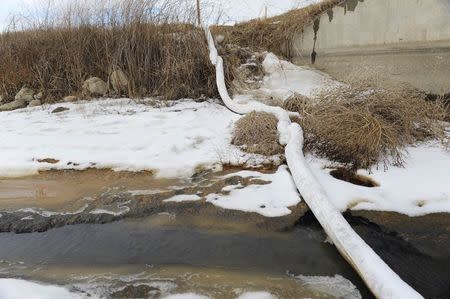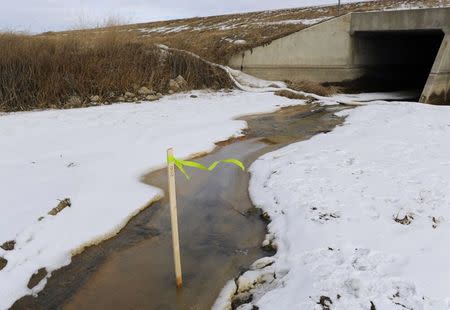Millions of gallons of saltwater leak into North Dakota creek
By Ernest Scheyder WILLISTON, N.D. (Reuters) - Almost 3 million gallons of potentially toxic saltwater leaked from a western North Dakota pipeline into a creek that feeds the Missouri River, the largest spill of its kind in the state's history. The leak, from a four-inch saltwater pipeline operated by Summit Midstream Partners LP approximately 15 miles north of Williston, occurred earlier this month and was reported to state officials on Jan. 7. It's not clear what caused the leak and an investigation is underway, a Summit spokesman said. Saltwater spills are not uncommon in the oil patch, though the size of the Summit leak has caught many by surprise. While the spill was first reported publicly on Jan. 8, a statement late Wednesday from the Department of Health was the first to disclose the spill's volume. The impact of spill on the local environment and the length of time needed for a cleanup is being assessed, officials said, though mop-up operations from other smaller accidents have taken years. "Our goal is: you make the mess, you clean it up," said Dave Glatt, spokesman for the North Dakota Department of Health. Saltwater is a byproduct of the hydraulic fracturing process, or fracking. The water has a much higher concentration of brine than regular saltwater, and can contain petroleum and metal filings picked up during the fracking process. Typically it is filtered and re-injected back into the earth after oil is extracted, though pipelines or trucks are required to transport it to injection sites. The leak does not pose a threat to drinking water supplies, the North Dakota Department of Health said in a statement released on Wednesday. Summit said it does not believe wildlife was affected. Several boom barriers had been placed in Blacktail Creek downstream from the broken pipe, according to a Reuters reporter who visited the area on Thursday. Parts of the creek were laced with a copper-colored sediment that did not resemble typical North Dakota soil, the reporter said. Remediation officials would not allow access to the site of the damaged pipe, which was a few hundred yards away from a small Lutheran church. It is by far the largest saltwater spill ever in North Dakota, eclipsing a leak of about 1 million gallons last July from a Crestwood Midstream Partners pipeline into Lake Sakakawea. The saltwater from the Summit line leaked into a creek that passes by Williston, considered the capital of the state's oil boom, and flows into the Missouri River. Williston's drinking water comes from the Missouri River, though the city's water department has the ability to turn off collection valves until any harmful material washes downstream. The state's Department of Health said it is monitoring cleanup efforts, and the state's Department of Mineral Resources is inspecting Summit's entire pipeline network, officials said. Summit has hired Stantec Inc to clean up the spill. About 2 million gallons of water have been pulled so far from one of the affected creeks, though it was not immediately clear if that amount was all saltwater or normal water flow. Remediation will be difficult given that much of the affected area is covered by ice. "We will continue to work tirelessly to see that the cleanup is completed," Rene Casadaban, Summit's operating chief, said in a statement. It's not clear when the line will re-open, though much of Summit's business involves natural gas transport, meaning day-to-day operations should largely be unaffected. Shares of Summit closed down 6 cents to $33.97 per share on Thursday. In the past three months the stock has lost 29 percent of its value, part of a broader sell-off in the energy industry amidst low oil and natural gas prices. (Reporting by Ernest Scheyder; Editing by Leslie Adler and Alan Crosby)






